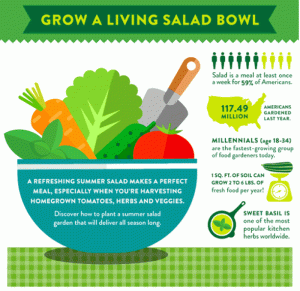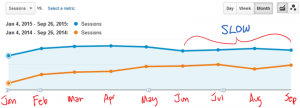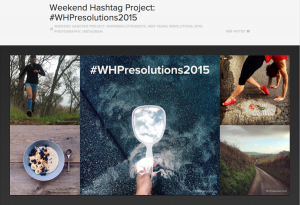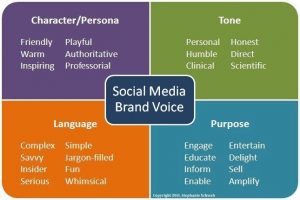— December 29, 2017
In 2017, it is still possible to say no, email is not dead! Despite the excitement of social networks, more than 225 billion emails should be sent daily this year, an increase of 50% over previous years.
From a marketing point of view, an email is a valuable tool for connecting with your customers. According to a recent study, 72% of consumers say that email is their favorite means of brand communication.
Like any marketing method, email adapts to changing customer preferences year after year. Now that 2017 is almost ended, the time has come to review email marketing best practices.
HOW TO DO GOOD EMAIL MARKETING
1 – BUILDING A MAILING LIST
Developing your mailing list without purchasing email addresses can be particularly frustrating. But this practice is pretty much in the same vein as buying links. The list you will get is likely to be of poor quality and, most importantly, having a gigantic mailing list does not mean more clicks and openings in return.
On the contrary, sending an unexpected email to recipients who have not chosen to subscribe to your newsletter, and perhaps never even heard of you, may condemn you in the spam folder.
Instead, try to build your subscriber lists the right way. Encourage your users to subscribe by offering a product promotion or white paper access and looking for opportunities to promote your newsletter subscription to:
- Your website
- Your blog
- Your landing pages
- Your thank you pages (after users fill out a form)
- At events
But most importantly, do not take your subscribers into deals. When entering their email address, clearly indicate what they are signing up for.
To do this, the best practice is to put in place an opt-in principle (see double opt-in). Indeed, it is not because a visitor to your website has created an account with his email address or participated in one of your contests, that he wishes to receive your marketing emails.
So, at the time of registration, do not forget to add an unchecked field allowing users to click on them only if they agree to receive your newsletter. You build a list of really engaged and motivated subscribers to receive your emails.
2 – AVOID SPAM
In recent years, mail servers have been using filtering systems to determine which emails end up in the inbox spam folder.
To avoid being part of it, make sure to respect these few criteria:
- Collect only the email addresses of subscribers who have given you their consent to send emails.
- Clearly indicate your entity in your emails, specifying several ways a customer can contact you (phone number, address, social network accounts, etc.).
- Avoid sending too many marketing emails over too short a period.
- Avoid using capital letters and exclamation points. Talk to your customers the way you would with a friend. If you talk about your new collection with a friend over a drink, you would not start by shouting “It’s FREE! GUARANTEE!!!! “. So do not do it in your emails either. Many readers say that they associate capital letters, exclamation marks, and other symbols with spam. And the automatic messaging filters too.
- Make unsubscribing easy for your users, including a clear link in your email. If your recipients cannot unsubscribe from your mailing list, they will find the spam button very simply.
- Clean up your address book by getting rid of any bouncing email address. Indeed, each recipient of your list who receives, but never opens your emails, is taken into consideration by the filters of the messaging platforms to determine if a particular message is a spam or not.
3 – COMMITMENT
The fact is that people who subscribed to your newsletter two years ago, two months or even two weeks may no longer be interested in your emails. As a result, constantly monitor your engagement settings, such as openings, clicks, and unsubscriptions.
You can also set up a re-engagement campaign, which is a great way to keep your mailing list up-to-date and remove inactive addresses.
To do this, determine your deletion rates and recipients who have always had a low engagement rate. Send them an email asking if they are still interested in receiving your messages or if they wish to change the receiving frequency. This will help you create a more effective mailing list and, as a bonus, remind your customers that you care about reducing the number of useless emails they receive.
To better hope to rehire them, you can include a special offer. But if your re-engagement campaign does not work with some subscribers, it’s time to remove them from your list.
In any case, it will always be better to send your emails to a small list of highly engaged recipients, rather than a gigantic list that never commits. It is also important to have a clean and complete mailing list. When a customer opens a personalized email with his or her name, rather “Sir”, “There” or any other generic type of reference. If you have engaging recipients like got from the sales department, web subscription but not with name or address or designation, I suggest you go to Email address matching services or follow these Email append best practices.
4 – PERSONALIZATION: SEGMENTATION AND DYNAMIC CONTENT
Custom emails get 29% more open and 41% higher click-through rates. So why not take advantage of all the data you have on your customers to customize the emails you send them?
In 2017, personalization goes well beyond simply calling the recipient by their first name. You can go further with the effective email segmentation to avoid spam and that will allow you to send the right message to the right person at the right time.
Segment your users according to their online behaviors, the actions they take and identifying their interests or preferences. What emails do they open? In which emails do they click? What are their hours of activity? What have they bought lately? Where do they live?
You will be able to harvest this type of information by integrating Google Analytics. This tool will allow you to view the bounce rates of your emails, compare the performance of each, get demographic information and, of course, track the openings and clicks of each of your marketing emails.
From this segmentation work, you can save mailing lists according to different criteria and thus better customize your emails.
In addition to segmentation, you can also try other customization methods, such as dynamic content. With dynamic email, content is personalized for each subscriber, based on the data you have about it.
The example below with Grammarly, a spelling and grammar correction tool that created a dynamic email marketing to show a subscriber how they used the service in 2017:
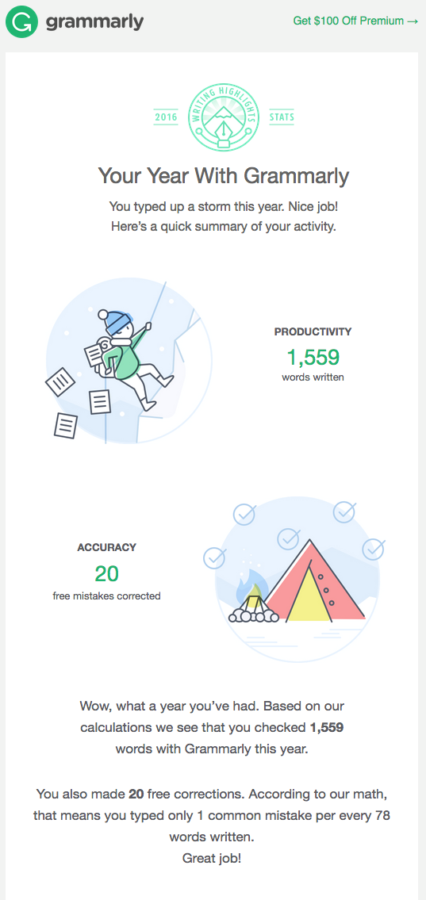
Thanks to the dynamic content, the numbers included in the email are unique for each subscriber. By using the dynamic content of this type, the recipient can obtain a personalized snapshot of his account information.
You can easily produce basic dynamic content with a tool like AWeber. To do this, create a registration form that asks your subscribers for personal information beyond their first name and last name. Then use custom fields in your email to extract information specific to each subscriber.
5 – AUTOMATION
Companies using automation see conversion rates 53% higher than those who do not use it. For some brands, automatically sent emails, such as welcome emails or cart abandonment, generate the majority of their email marketing revenue.
If you do not use email automation yet, 2017 is the time to start! Here are some types of emails with which to apply automation:
- Welcome email / thanking a user to subscribe
- Email reminder of sales and upcoming events
- Post-purchase tracking email
- Email triggered by behavior: abandoned cart, no connection to your website for a long time, etc.
- Investigation Email
You can also use automation to send an email thanking the subscriber on the anniversary date of their membership. This simple practice can boost loyalty by making valued customers feel valued. For example, you might consider sending a secret special offer to your customers who subscribed to your mailing list more than 2 years ago and made a purchase at least once on your e-commerce.
6 – CTA
Your call (s) to action (CTA) is one of the most important elements of your email marketing since it encourages subscribers to click on your content.
If you are promoting a sale or want your subscribers to download an eBook, only one CTA should suffice. But sometimes, several calls to action may be appropriate. To find the most adapted, you can test what resonates best with your subscribers.
Also focus on the following 4 ideas when designing your CTAs:
- Location: CTAs placed at the bottom of an email marketing see an average increase of 17% conversions, compared to those placed at the top or in the middle.
- Design: Choose the right color and make sure your CTA stands out from the rest of the content.
- Context: Create contextual content and leave enough space around your CTA to catch the eye and help motivate a click.
- Clarity: Be both clear and concise in your request.
7 – VALUE
Email marketing can sometimes be perceived by recipients as too toxic or promotional.
Do not ask too much of your subscribers from the start, only having your sales in mind. Email marketing is about relationship building and prospect acquisition, and every interaction you have with your subscribers will have to provide value.
Before encouraging them to buy one of your products, or register for one of your services, offer them first interesting information, entertainment or a good deal.
Referring them to a white paper with useful tips on your area, sharing a “Top 10” information list, or providing a discount code will encourage them to start at first.
8 – OBJECT LINE
The subject lines are the first thing your subscribers see. If you want your email to be open, it is therefore important to carefully craft your subject, especially by focusing on certain action verbs and keywords (“free”, “tomorrow”, etc.).
Although there are no strict rules on what works in terms of the subject line, make sure that they always indicate what is in your message. Also avoid “click trap” objects such as “Open Now”, “Seize Your Chance” or “Single Offer”, which are inefficient.
Instead, think about how you can differentiate your brand in the clutter of an inbox. Include snippets of information that intrigue readers and make them want to click open.
Some other interesting facts about the subject line:
- 33% of recipients decide to open an email or not by reading it.
- Custom object lines are 2% more likely to be open.
- The subject lines implying urgency or exclusivity are open 22% more.
- Object lines with a number of characters less than 15 are the most open, but subject lines with 28-39 characters maximize your click-through rate.
- The subject lines concerning the reductions have an opening rate of 52%.
9 – INTERACTIVITY
With moving elements and clickable content, websites tend to be visually more interesting than an email.
However, 2017 is starting to become the year of change as major email platforms, like Gmail, now support interactive emails.
An interactive email contains one or more element (s) with which the subscribers can engage and interact. Typically, this means that an item changes when the recipient clicks or types something. Interactive email elements can take many forms, including:
- Hamburger menu and other navigation modes
- Carousels, image galleries
- Quiz
- Survey
- view
- Search Bars
- The functionality of adding to cart, etc.
Interactivity makes it possible to integrate directly into the email interactions that usually take place on the landing page, such as moving or rotating an image or clicking on different tabs.
Example of an interactive email
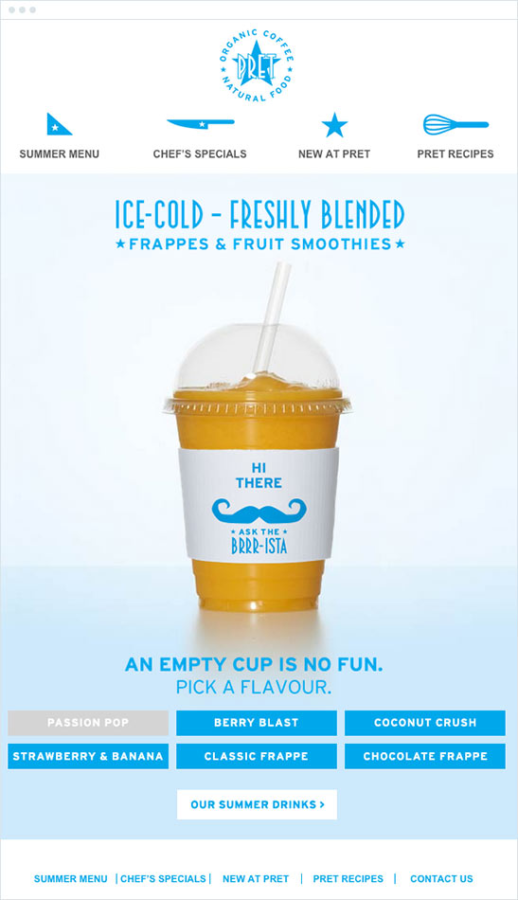
By allowing more interactivity inside the email, it becomes possible to reduce the obstacles to engagement and to get more clicks with a high intention.
However, creating an interactive element takes time, requires some coding knowledge, and is not supported by all messaging services. Before you spend time implementing an interactive email, you will need to be convinced of its positive impact on your click and engagement rates.
10 – MOBILE
In 2017, you are aware that the vast majority of Internet users do most of their browsing on mobile devices, including reading their emails.
As a result, if the messages you send are difficult to open and read on a smartphone or tablet, you risk losing a large portion of your customers. According to a recent study, 63% of emails are deleted immediately if they are not optimized for mobile.
So that your subscribers who read their emails via a mobile can access them:
- Reduce the size of your images with compression.
- Use an HTML email editor to change the style of your email marketing so images are sized by screen rather than by pixel.
- Increase the size of your buttons and links.
- Think about investing in a responsive email template.
- Avoid overloading your emails with rich media.
11 – TESTS
An excellent way to reduce unsubscribes is to test multiple variables to determine what has the greatest impact and engagement with your subscribers. You can perform A / B testing on the layout, offering, charts, call to action, subject line, and all other aspects of your email marketing.
Proceed with both of these tips in mind:
- Test only one item at a time (otherwise, your results will not be conclusive)
- Make sure you have a significant sample size for your tests
The idea is to perform your tests on your most engaged subscribers: those who open and almost always click your emails. Thus, if you have a new CTA or any other new item to test, they will be a great help to you to see how to improve your messaging strategy. Also be sure to reward them with special offers and discounts to better keep them.
12 – METRIC
To determine how well your email marketing resonates with customers, and how well it meets your primary goals, it’s important to monitor the messages you send.
There are many ways to measure the success of an email marketing campaign, so you need to carefully choose metrics to use before sending anything. In other words, always think about what you want to achieve, your goals and the purpose of each of your emails.
Do you want to generate more leads? Get more sales from your most loyal customers? Increase brand awareness?
For example, if you want your recipients to read a significant update to your terms of service, you will need to use a convincing subject line and measure your open rate. On the other hand, if your goal is to extend an offer or discount, clicks (and subsequent visits and conversions of your offer) will be your main parameter to watch for.
Other metrics can also serve you, such as rebounds, subscription rates, and unsubscription rates.
Digital & Social Articles on Business 2 Community
(72)
Report Post
